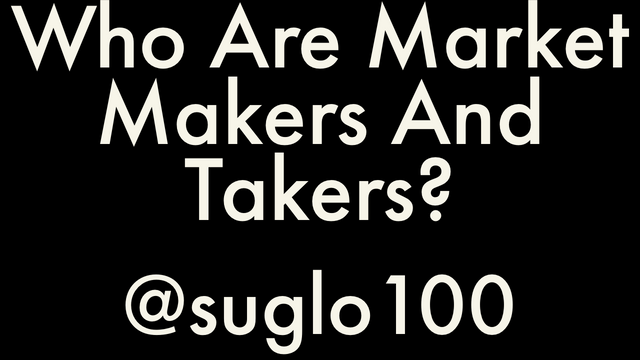The Concept Of Market Makers And Takers.
Greetings everyone.

Today I want to discuss with you who or what market makers and takers are. In the crypto ecosystem, almost every market is made up of makers and takers. These makers establish buying or selling orders that are not executed immediately. Let’s consider this example, sell Tron (TRX) when the price hits $1. This establishes liquidity, in a sense that it is easier for others to instantly buy or sell TRX when the condition is met. Those people that buy or sell instantly in the market are referred to as takers.
Within all the exchanges be it Forex, stocks, or cryptocurrency, sellers are matched with buyers. Without these condition, investors had to advertise or market their offers to trade Bitcoin for Tron on social media, hoping that someone will be interested.
In this post, I will be talking about the concept of makers and takers. Every trader or investor falls into at least one of these categories. Indeed, as a trader or an investor, you will sometimes act as both at some particular period of time. These makers and takers are the motherboard of many exchange platforms, and their presence determines strong exchanges from weak exchanges.

Now, before we can all get the understanding of makers and takers properly, it is important to know much about liquidity. So I will talk on liquidity before proceeding to the main topic of the day. We have been hearing people saying this asset is liquid or this asset is illiquid, they are simply referring to how easy you can sell that particular asset.
For example, gold is a very liquid asset because it can be easily exchanged for fiat within a short period of time. Again, a statue of the polyneix ceo is a highly illiquid asset. Though it may look great in someone’s front garden but the reality is that not everyone would be interested in such a thing.
A liquid market refers to one where you can trade in assets easily at a fair price. In such a market, there is always high demand from people who want to get the asset and high supply from people who want to release it.
With regards to the above mentioned, buyers and sellers tend to meet in the middle of the market. The least sell order will almost be the same as the highest buy order. Due to that, the difference between the highest buy order and the least sell order would be small. This difference between the highest buy order and the least sell order is term as Bid-ask spread.
In the other way round, an illiquid market possess none of these properties. If you want to offload an asset, you will have difficulty in doing so at a fair price because the demand in the market is not that much.
Now that we have understand what liquidity is, let’s get into our main business of the day which is makers and takers.

An order book is use to calculate the market price of an asset on exchange platforms. This is where it gathers all the offers to purchase and to sell from its clients. You may enter an order to buy 800 TRX at $60. This order is added to the order book and will be executed or fill when the price is triggered.
Maker Order like the one I have just explained in the above paragraph requires that you place it with your aims ahead of time by adding them to the order book. You are called a maker because you have made the market, in a way. The exchange platform is like a grocery store where individuals are charged to put goods on the shelves, and you are the one adding your own inventory.
It normal for big traders or investors and organizations to take on the role of market makers. In another words, small traders or investors can become makers, by entering some order types that are not carried out instantly.

Let’s continue with the grocery store analogy, after putting your stuff on the shelves, it simply means you are putting your stuff on the shelves for someone to come and buy it. This particular person coming to buy it is referred to as the taker. You can now clearly see that, makers supply the store with groceries making it a liquid store and takers then come and buy from these groceries.
If you enter a market with an order which is added to the order book, you have increased the liquidity of the exchange due to how simple you have made it o users to buy or sell. Just like I have mentioned, a taker removes part of that liquidity in the market. With a market order to trade at the current market price. When this is done, existing orders on the order book are filled instantly.
If you have ever placed a market order on Binance or another exchange platform to trade, then you have acted as a taker in that scene. The simple ideology behind being a taker is, whenever you fill an order you are referred to as a taker.

To conclude with, makers are those that create orders and wait for them to be executed while takers are those that execute others orders. The most important thing here is that market makers are the liquidity providers.
For exchange platforms that use a maker-taker model, the makers are very important to the platform’s exposure as a trading venue. In general, exchanges reward makers with lower charges as they provide liquidity. Again, takers make use of this liquidity to easily trade assets.
Twitter Shared
@tipu curate
Upvoted 👌 (Mana: 4/6) Get profit votes with @tipU :)